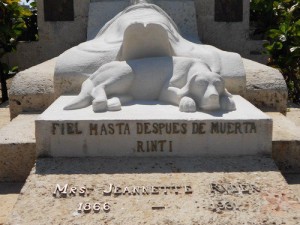THE TOMB OF LOYALTY, COLON CEMETERY, LA HABANA.
People describe her as a slender, short-statured woman who walked the streets of Havana feeding stray dogs and cats. Some called her crazy – the label often applied to those who selflessly aid the needy.
However, Jeannette Ryder gradually won over people to her cause, people who began to admire her for her perseverance, her confrontations with horse drawn coaches who mistreated the animals and her opposition to bullfighting in Havana. Ryder also aided women, children and elderly people in need and courageously stood up to the authorities of her day to reach her goals.
In the city where she carried out her noble tasks, Jeannette Ryder is remembered by people who, like her, fight against animal abuse and cruelty. Every second Sunday in April, in commemoration of her death on April 11, 1931, a symbolic pilgrimage to her resting place in Havana’s Colon Cemetery is organized. This year, the group was small (though it hasn’t been so on other occasions). The small turnout did not, however, dampen people’s good intentions.
It was an emotive and sincere tribute. Some took their pets and others joined the procession along the way (as did a watchman at the cemetery, who asked direct questions, very concerned to find out who we were and what we were doing there).
Once we reached her tomb, the more uninhibited in the group spoke about Jeannette’s life: her work, her will and her noble feelings. Nora, the director of the Cuban Association for Animal and Plant Protection (Aniplant) mentioned all of the work that still needs to be done to bring about the passing of an animal protection law in Cuba and, with great optimism, acknowledged that Jeannette was fortunate, as the government of her day did support her in some efforts (offering her an ambulance, a shelter and other things). She added that we too are going to achieve such things. According to Nora, what we need to do is continue working.
It was a fitting tribute to this US citizen who arrived in Cuba at the end of the 19th century and, in 1906, founded the Society for the Protection of Children, Animals and Plants, also known as the Bank of Charity. Ryder, a tireless activist, created a dispensary for children and fed the homeless and women in prison. Among other things, she fought against the sale of children.
The homage became a meeting point for several people who protect animals in Havana, sometimes at their own expense and despite the rise in prices at veterinary clinics. These efforts receive very little recognition and are becoming more and more intense, as human indolence knows no limit and the number of stray animals getting sick or suffering accidents is constantly growing. It is therefore important to establish contacts, to help one another in the arduous and gratifying task of aiding those in need. They are certainly deserving of such aid.
It is said that, when Jeannette’s remains were taken to the cemetery, her little dog Rinti, who used to go with her everywhere, sat next to the grave and didn’t want to eat or leave the place…until she also died. Years later, the beautiful sculpture commemorating this prevents the image from disappearing from memory.
It may be the lack of publicity or the apathy that characterizes us, but it is shocking that these processions do not draw more people, as Jeannette Ryder’s sensitivity excluded no one.
HavanaTimes/Irina Echarry/InternetPhotos/TheCUbanHistory.com
The CUban History, Hollywood.
Arnoldo Varona, Editor.
LA TUMBA DE LA LEALTAD, CEMENTERIO DE COLÓN, LA HABANA.
En el sorprendente Cementerio de Colón, en Cuba, salta a la vista la escultura de una mujer acostada, y a sus pies, un perrito. La obra, hecha con piedra de cantería, se inauguró en 1944, con la bendición del Arzobispo de La Habana. Pero, ¿quién fue la Dama del Perrito?
Jeannette Ryder (Wisconsin, ? – Cuba, 1931) fue una filántropa norteamericana que vivió en Cuba a principios del siglo XX, donde fundó la organización humanitaria llamada Sociedad Protectora de Niños, Animales y Plantas, también conocida como el Bando de Piedad.
Tras concluir la dominación española en Cuba y en momentos en que nuestro país se hallaba bajo la primera intervención de los Estados Unidos, desembarcó en el puerto habanero una mujer norteamericana de 33 años de edad nombrada Jeanette Ryder.
Al poco tiempo de su llegada a La Habana esta mujer se inició en la tarea de ofrecerles ayuda a los numerosos niños desamparados que recorrían la ciudad, se dedicaban a vender periódicos, en el mejor de los casos, o al hurto continuado. Se detenía a hablar con ellos, se interesaba por la situación individual de cada uno, les orientaba a seguir el buen camino y apartarse del delito y de los vicios y en muchas ocasiones recurría a sus escasos recursos monetarios para entregarles una limosna.
Jeannette Ryder. Muy diminuta, muy delgada y muy poco agraciada, al margen del patrón de belleza de los hombres cubanos, aquella mujer no conoció el galanteo constante de los nativos. Sin embargo, la belleza que no podía ostentar su figura habitaba, con creces, en sus nobles sentimientos cristianos, en su sensibilidad extrema y en su firme voluntad de hacer el bien.
Fue enterrada en la necrópolis de Colón en la ciudad de La Habana. Su tumba se conoce como la tumba de la lealtad, ya que después de su muerte, su perra Rinti se echó a los pies de la tumba y rechazó los alimentos y el agua que le ofrecían los cuidadores del cementerio hasta que murió. Una escultura conmemorativa muestra a un perro descansando a los pies de la tumba.
En julio de 1957, para conmemorar los 50 años de la fundación del Bando de Piedad, el Ministerio de Comunicaciones de la República de Cuba emitió dos sellos de 021_0014 y 12 centavos respectivamente honrando a Jeanette Ryder.
Cjaronu/Marrero/Gribalbali/Internet photos/www.TheCubanHistory.com
The Cuban History, Hollywood.
Arnoldo Varona, Editor.



 THE TOMB OF LOYALTY, Colon Cemetery, Havana. + LA TUMBA de la Lealtad, Cementerio de Colón, La Habana.
THE TOMB OF LOYALTY, Colon Cemetery, Havana. + LA TUMBA de la Lealtad, Cementerio de Colón, La Habana.


